Update 31st January 2025: Please be aware that the VMware Documentation site has been migrated to it's new home at Broadcom TechDocs. As a result of this, I have been informed that some external links in this site no longer function correctly. If you do find a broken link before it is replaced, please reach out via social media and let me know!
Warning! The content within this article is over 36 months old and, therefore, may be out of date.
HOWTO: Configure the VMware Identity Appliance for vRealize Automation 6.x
VMware vRealize Automation VCAP6 VCAP6-CMA
Published on 10 January 2017 by Christopher Lewis. Words: 435. Reading Time: 3 mins.
Introduction
This post is a part of a series of posts for preparation for the VCAP6-CMA Deploy exam. For the full exam prep resources check here .
Prerequisites
The following are prerequisites for this post:
- A deployed VMware vRealize Identity Manager Appliance - see Deploy the VMware vRealize Identity Appliance from OVA
Configuration Overview
The high level configuration steps for this appliance are:
- Connect to the Identity Appliance VAMI
- Configure the Time/NTP settings
- Confirm the Network Settings
- Configure the SSO Administrator Password
- Configure the SSO Hostname
- Configure the SSL Certificate
- Join the Identity Appliance to Active Directory
Step by Step Walkthrough
Connect to the Identity Appliance VAMI
- Using a web browser, navigate to VAMI of the Identity Appliance
https://identity-appliance.fqdn:5480.
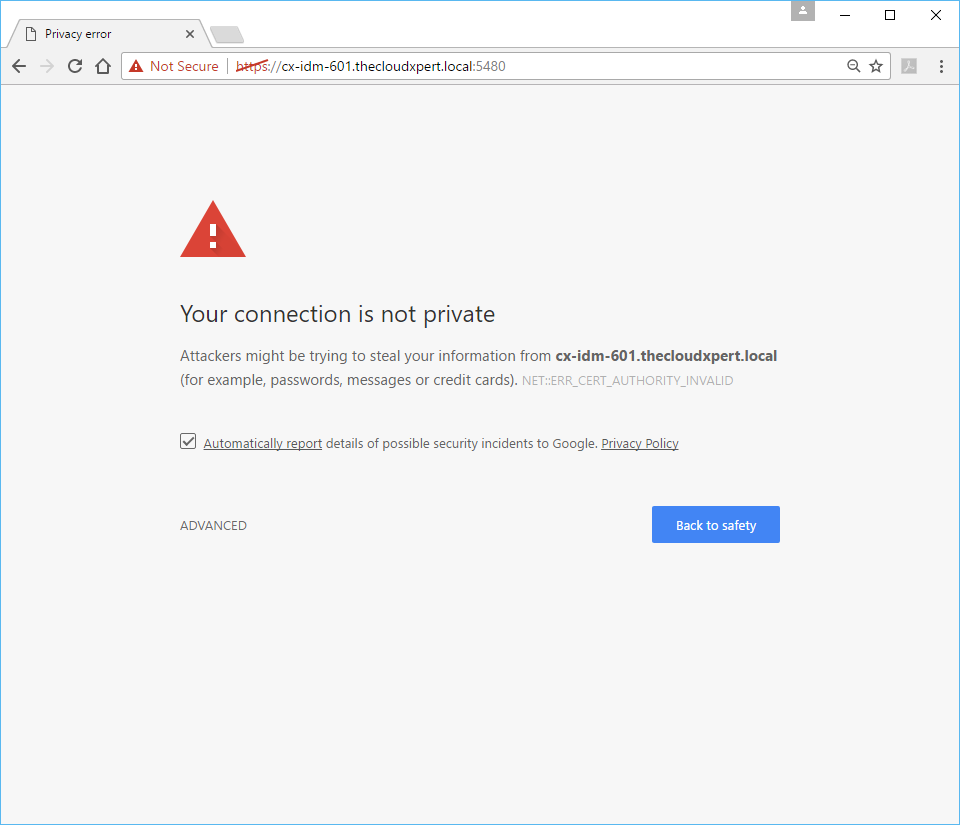
- Click Advanced and then click Proceed to
identity-appliance.fqdn(unsafe).
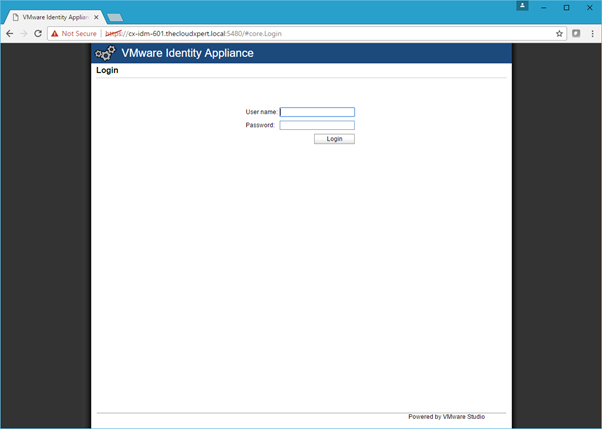
- Enter root into the User name text field and the password for the root account into the Password text field. Click Login.
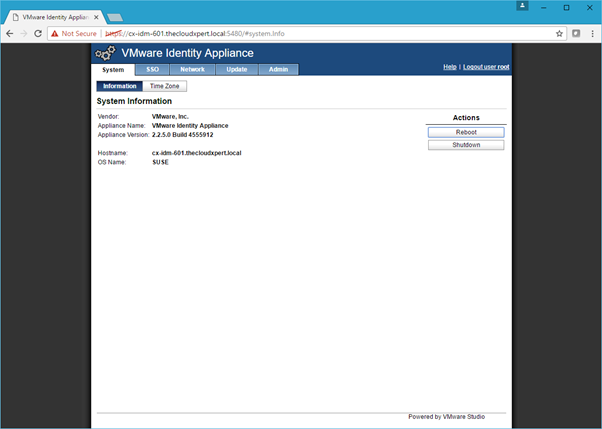
Configure the Time / NTP Settings
- Click the Admin Tab and then the Time Settings Tab.
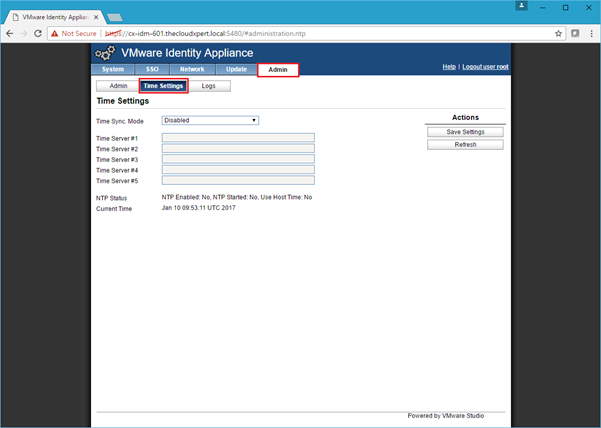
- Select Use Time Server from the Time Sync. Mode dropdown and enter the time server(s) in the text field(s) and click Save Settings.
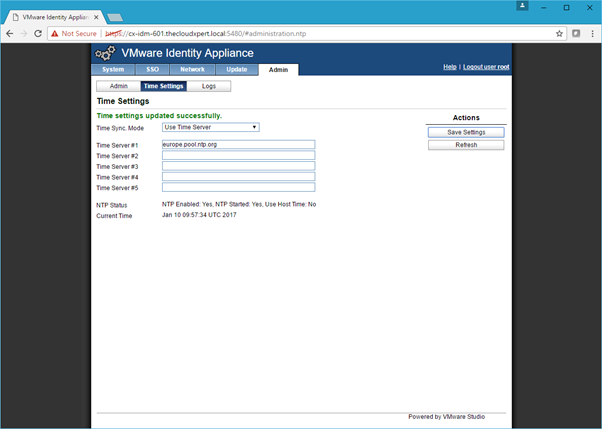
Confirm the Network Settings
- Click the Network Tab to confirm the network settings of the Identity Appliance are correct.
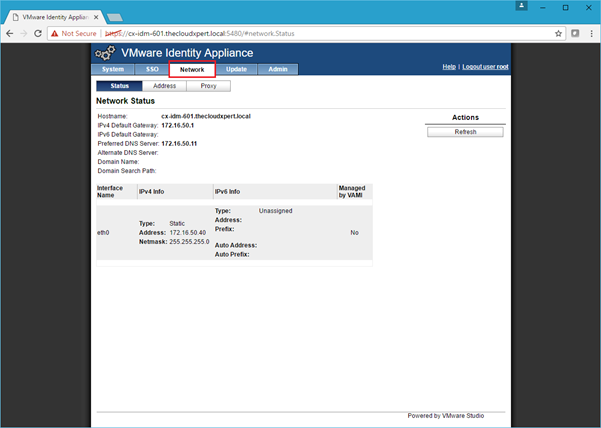
Note:
If the settings are incorrect, click the Address Tab, update the relevant settings, click Save Settings and then reboot the appliance.
Configure the SSO Administrator Password
- Click the SSO Tab.
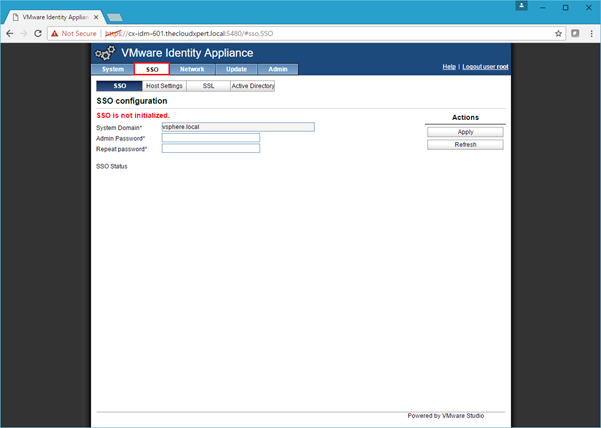
- Enter the desired admin password into the Admin Password and Repeat password text fields and click Apply.
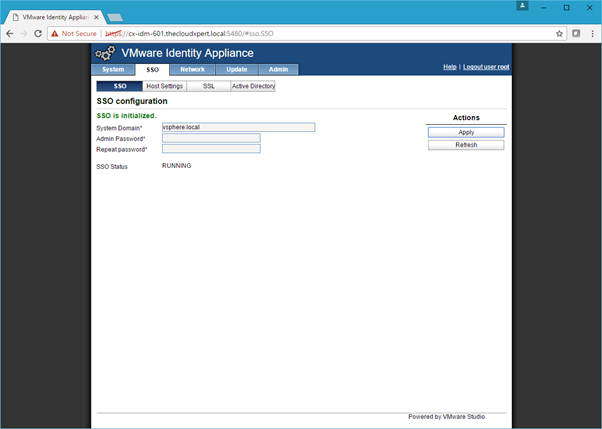
Configure the SSO Hostname
- Click the Host Settings Tab.
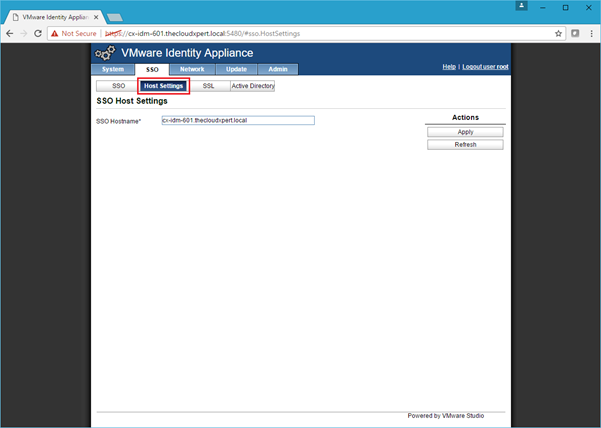
- Confirm the name of Identity Manager Host is correct in the SSO Hostname field and click Apply.
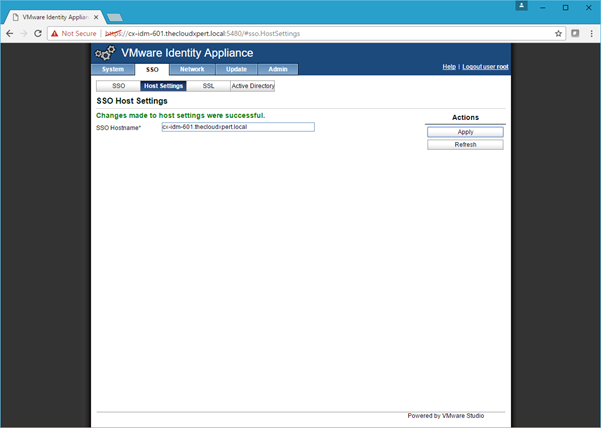
Configure the SSL Certificate
- Click the SSL Tab
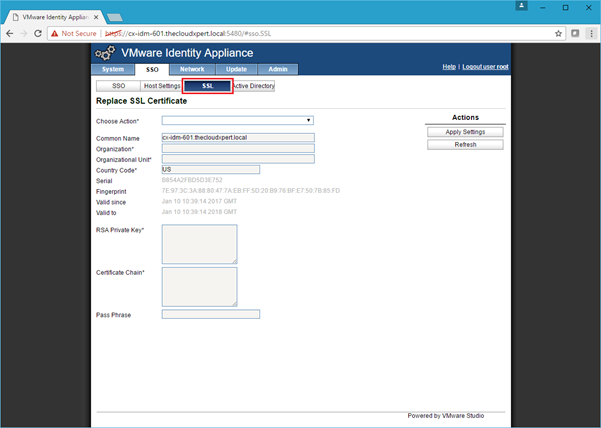
- From the Choose Action dropdown, select Import PEM encoded certificate.
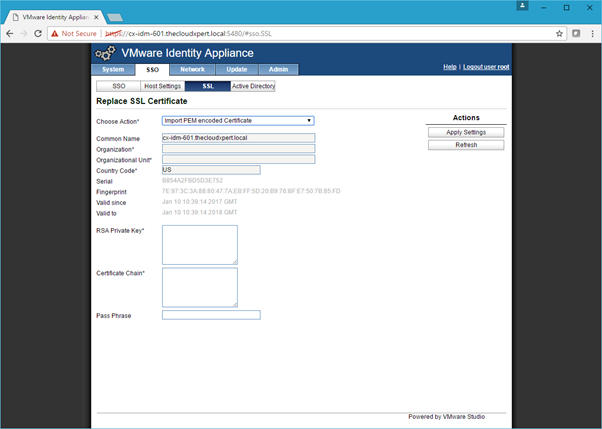
- Copy the entire contents of the Private key file into the RSA Private Key text field (including
-----BEGIN RSA PRIVATE KEY-----and-----END RSA PRIVATE KEY-----).
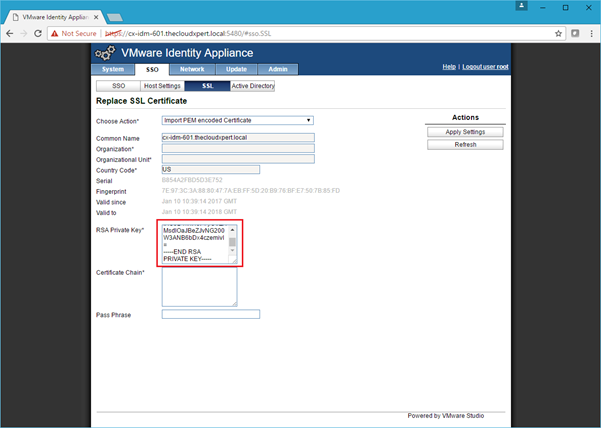
- Copy each SSL certificate the Certificate Chain into the Certificate Chain text field (including the
-----BEGIN CERTIFICATE-----and-----END CERTIFICATE-----lines).
Note:
The certificate chain should be Appliance SSL -> (if applicable) Subordinate CA SSL -> Root CA SSL.
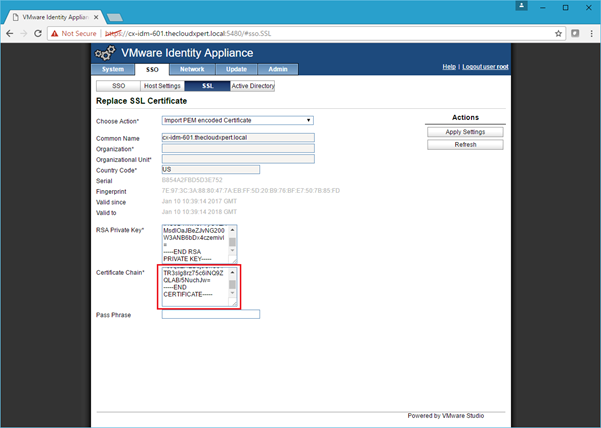
- Click Apply Settings.
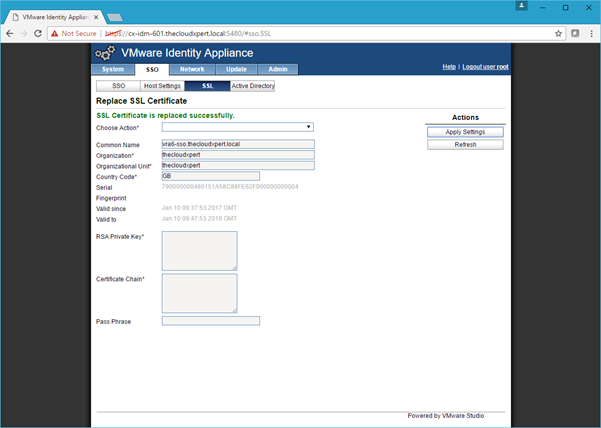
Join the Identity Appliance to Active Directory
- Click the Active Directory Tab.
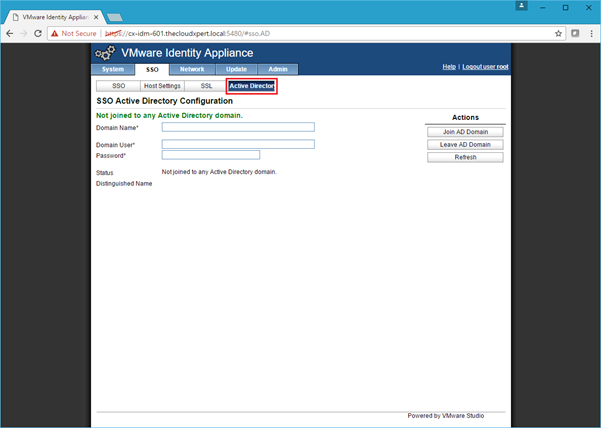
- Enter the Domain into the Domain Name text field, the user into the Domain User text field and the password into the Password text field. Click Join AD Domain.
Note:
The user detailed here is only required to add the Identity Appliance to AD so that Integrated Windows Authentication can occur.
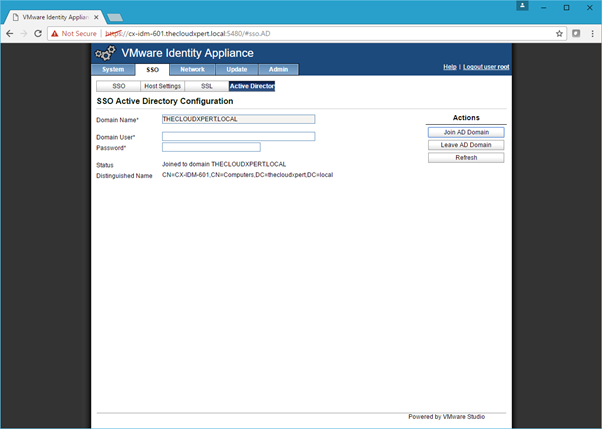
- Click Logout user root.
Published on 10 January 2017 by Christopher Lewis. Words: 435. Reading Time: 3 mins.
Related Post(s):
- HOWTO: Deploy the VMware vRealize Automation 6.x Appliance (OVA) ()
- VCAP6-CMA Deploy - Objective 3.2: Deploy and Manage Certificates and Access Control ()
- Achievement Unlocked: VMware Certified Implementation Expert 6: Data Center Virtualization ()
- Achievement Unlocked: VMware Certified Advanced Professional 6 - Data Center Virtualization Design ()
- Achievement Unlocked: VMware Certified Advanced Professional - Data Center Virtualization Deploy ()
Recent Posts:
Blog Categories:
active directory 6
aria automation 9
aria automation orchestrator 1
aria operations 2
aws 2
blog 1
career 1
certificate authority 5
certificates 5
certification 91
cloud management 1
cloudnativecon 1
community 1
fun 1
general 9
hands on labs 1
home lab 2
kubecon 1
kubernetes 1
microsoft 7
nsx 45
nsx v 41
powercli 8
powershell 6
reviews 1
vcap 48
vcap6 2
vcenter 4
vcix 2
vexpert 9
vmug 5
vmware 99+
vmware aria 1
vmware aria automation 9
vmware aria automation orchestrator 1
vmware aria operations 3
vmware cloud 3
vmware cloud director 1
vmware explore 2
vmware identity manager 2
vmworld 36
vrealize automation 80
vrealize automation saltstack config 1
vrealize business 2
vrealize log insight 1
vrealize operations 1
vrealize operations manager 5
vrealize orchestrator 13
vrealize suite 14
vrealize suite lifecycle manager 20
vsan 5
vsphere 9
windows 6
Top Tags:
active directory 6
api 18
barcelona 24
certificates 11
certification 7
howto 33
microsoft 7
multi tenancy 9
nsx v 43
platform services controller 8
powercli 8
powershell 7
psc 6
vcap 9
vcap6 45
vcap6 cma 48
vcap6 nv 37
vcix6 nv 36
vexpert 19
vmug 8
vmware 99+
vmware aria 10
vmware aria automation 9
vmworld 35
vmworld 2016 13
vmworld 2017 9
vra 13
vrealize automation 74
vrealize operations 8
vrealize orchestrator 21
vrealize suite lifecycle manager 11
vrslcm 20
vsan 7
vsphere 12
